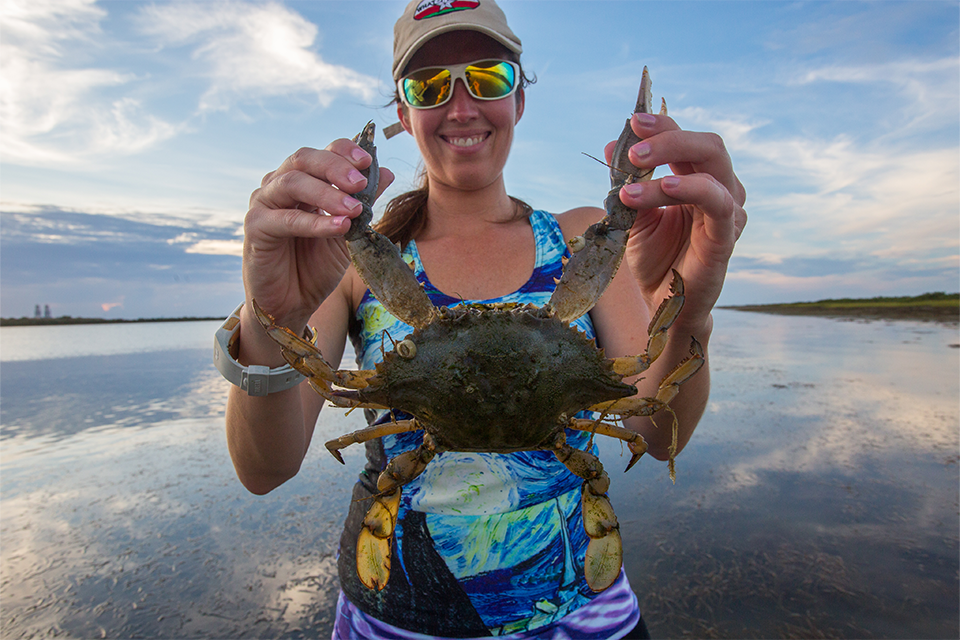Texas Shorelines: Feeling Blue About Seafood? Consider the Crab.
Feb 22, 2023 By Corley-Ann Parker
4 minutes
 A recreational fisher with a crab catch.
A recreational fisher with a crab catch.COLLEGE STATION, Texas — When it comes to crabs, Texas isn’t the first state that comes to mind. However, the Texas commercial crabbing industry landed over 3 million pounds of blue crab in 2021, and recreational crabbing is considered a staple in many Texas coastal communities. So, if you’re looking to include more crab in your diet or are interested in catching any on your next trip to the coast, there are a few things you should know.
The blue crab (Callinectes sapidus) is the most commonly caught edible crab in the Gulf of Mexico. In fact, their scientific name translates from Latin to mean “beautiful, savory swimmer.” These crabs are known for their signature blue claws, and mature females will also have bright red tips on their claws!
These crustaceans are found in a wide variety of habitats in Texas, from the saltiest waters of the gulf to brackish bays and estuaries. Blue crabs are also notoriously indiscriminate with their diets, eating almost anything from oysters and fish to other smaller crustaceans!
Many of the blue crabs in Texas are caught commercially using rectangular crab traps made of chicken wire. These traps are usually about two feet wide and have inverted funnels on the sides that allow crabs to enter the trap but prevent them from being able to exit. There are no public waters or seasons for crab harvesting except for one week in February when Texas bays are closed to crabbing to clean up lost or abandoned traps. During this period, any traps in the water are considered fair game to be legally removed.
People also catch crab recreationally in Texas since it is an easy and relatively inexpensive activity. “As far as recreational fishing goes, crab can be one of the easiest things to catch,” says Matagorda County Extension Agent Nicole Pilson-Macias. “You don’t need much [to catch crabs] and they can be found almost anywhere near piers or docks.”
One of the most common ways to catch blue crab is with a strong piece of twine baited with fish heads or chicken necks (two of the blue crab’s favorite snacks) on one end. There are no bag limits for blue crab in Texas, but any crabs that measure less than 5 inches in width must be released, and keeping female crabs with spongy masses of eggs on their abdomen—commonly referred to as sponge crabs—is illegal.
Once crabs are caught, they should be kept either in a bucket with a small amount of cold water, or on ice. Crabs should be cleaned quickly after catching to prevent any meat spoilage, and any dead crabs that are found should be discarded. Be sure to refrigerate any cleaned crab meat as soon as possible! You can also find pre-packaged Gulf blue crab at your local fish market or supermarket—just remember to check the label to make sure you’re getting sustainable, U.S. seafood.
“Crab is a really versatile seafood,” says Pilson-Macias, “it can be anything from a fancy, impressive appetizer or social crab boil to a super simple dinner entree.” So, next time you’re thinking about adding more kinds of Texas seafood to your diet, consider the crab.
Other Resources:
texasoutdoordigest.com/fishing/crabbing-along-texas-coast-geared-toward-simplicity-fun-food/
texasview.org/crabbing-in-texas/
nps.gov/pais/learn/nature/crustaceans.htm
bluecrab.info/texas.htm
fisheries.noaa.gov/species/blue-crab
fisheries.noaa.gov/foss/f?p=215:200:15485107232243
tpwd.texas.gov/huntwild/wild/species/bluecrab/
####
Texas Shorelines is a service of the Texas Sea Grant College Program at Texas A&M University. Texas Sea Grant is a unique partnership that unites the resources of the federal government, the State of Texas and universities across the state to create knowledge, tools, products and services that benefit the economy, the environment and the citizens of Texas. It is administered through the National Oceanic and Atmospheric Administration and is one of 34 university-based Sea Grant Programs around the country. Texas Sea Grant is a non-academic research center at Texas A&M University. The program’s mission is to improve the understanding, wise use and stewardship of Texas coastal and marine resources.
